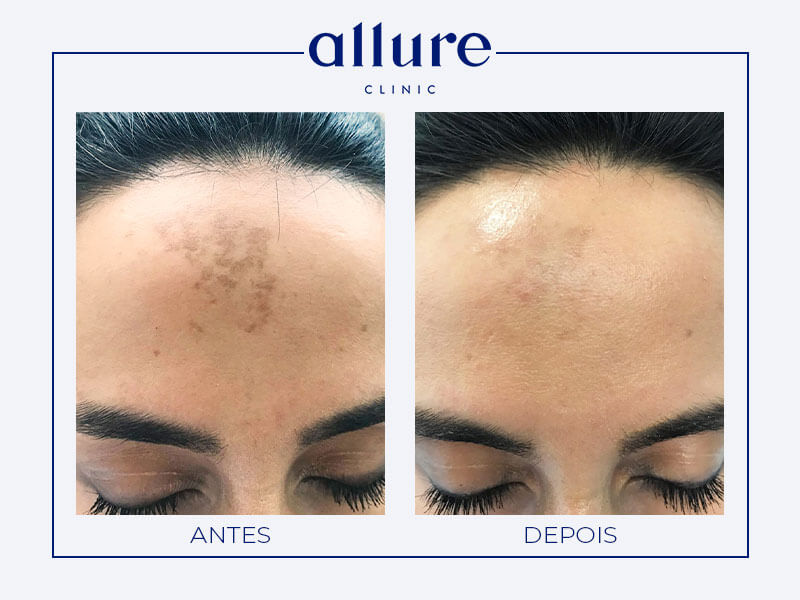
Learn more about skin blemishes
Watch the following videos for explanations from Allure Clinic dermatologist Dr. Ana Moreira about the causes and treatments for melasma. You can also watch the video about the facial rejuvenation options Allure Clinic offers.


What are Skin Spots?

Melasma is a benign skin condition characterized by localized hyperpigmentation of the skin – especially on the face.
The spots are usually brown, irregular, and symmetrical. In fact, they tend to appear gradually in specific areas of the face: the forehead, cheekbones, nose, and upper lip.
Its color varies throughout the year, but intensifies with exposure to sunlight.
These spots are commonly referred to as "pano" because they are common in pregnant women (10-15%). In these cases, they usually resolve spontaneously, which is not the case with other types of spots, which require appropriate and personalized treatment.
These spots resist over-the-counter creams and are very unsightly, spoiling the beauty of the face.
It is possible to distinguish the different types, depending on the layer of skin affected:
- Epidermal melasma: affects the superficial layer of the skin; in these cases, the stain is usually brown and has well-defined contours.
- Dermal melasma: increased pigmentation in the deepest part of the skin; characterized by spots with a blue/gray coloration.
- Mixed melasma: association between epidermal and dermal types; manifests as spots with brown/gray pigments.
The most appropriate treatment will depend on the depth of the affected skin layer.
You may have tried over-the-counter creams without success. This could mean that the problem is deep within the skin, meaning topical application of creams won't reach the problem.
During the consultation, the specialist doctor makes an assessment in order to prescribe the therapeutic protocol with the greatest chance of success for your particular case.
But before moving on to treatments, find out the cause.

Causes
Apart from a genetic predisposition and greater frequency of these spots in females, the mechanism underlying their appearance is still unknown.
It is known, however, that the spots are a reaction to the hyperproduction of melanin – a pigment produced by the body and responsible for skin color – which results from situations such as:
- Hormonal changes – such as during pregnancy, when there is a reduction in estrogen levels;
- Repeated sun exposure;
- Women with darker skin;
- Hormone replacement treatments (pill);
- Local inflammations, such as certain skin diseases;
- Age/aging;
- Some types of medicines.
It is very important to invest in prevention, avoiding, above all, sun exposure – even with a high sun protection factor – and reapplying every 2 hours.
Self-tanning creams should also be avoided.
Clinical Cases - Before and After
See the before and after photos of the treatment for this problem.



Treatment: Laser / IPL (intense pulsed light).
- Patient's age: 36 years old
- Problem: Melasma
- Treatment: Intense Pulsed Light (IPL)
- Results: Before and after photographs of two IPL sessions
Treatments
Laser / IPL (Intense Pulsed Light)
Laser or pulsed light are options with excellent results in the treatment of epidermal melasma.
Through photothermolysis, melanocytes—the cells that contain melanin—are destroyed, and the spots fade. This results in highly satisfactory results without damaging the skin.
Suspicious pigmented lesions and dermal-type melasma are not candidates for laser or pulsed light treatment.
Facial Peeling
This treatment seeks to eliminate or reduce brown spots.
It involves applying a chemical solution that exfoliates the skin – removing dead cells – and stimulates the growth of new skin cells and skin renewal.
It is a fast, effective therapeutic option performed on an outpatient basis.
Depigmenting Creams
There are several effective substances for treating blemishes, but these are creams that only a dermatologist can prescribe.
These products, with specific formulas, involve the use of substances on the surface of the skin whose objective is to reach the melanocytes – responsible for the excessive production of melanin and, thus, eliminate and/or reduce unsightly spots.
Medical Specialist
in Melasma
Dr. Ana Isabel Moreira
- Aesthetic Dermatologist
- Graduated from the Faculty of Medicine of the University of Porto
- Specialist in Dermatology and Venereology
- Reviewer of scientific articles at the invitation of international journals
- Member of the Portuguese Society of Aesthetic Medicine (SPME)







